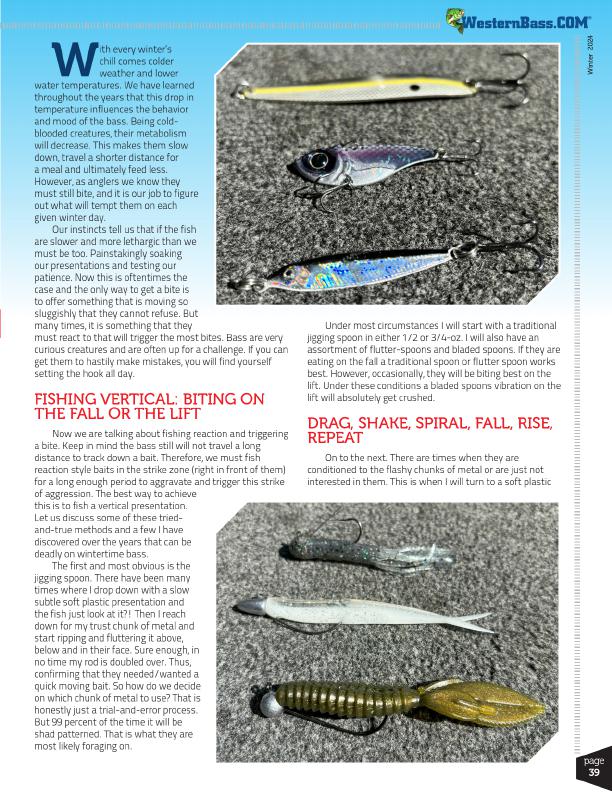
®
W
ith every winter’s
chill comes colder
weather and lower water temperatures. We have learned
throughout the years that this drop in
temperature influences the behavior
and mood of the bass. Being cold-
blooded creatures, their metabolism
will decrease. This makes them slow
down, travel a shorter distance for
a meal and ultimately feed less.
However, as anglers we know they
must still bite, and it is our job to figure
out what will tempt them on each
given winter day.
Our instincts tell us that if the fish
are slower and more lethargic than we
must be too. Painstakingly soaking
our presentations and testing our
patience. Now this is oftentimes the
case and the only way to get a bite is
to offer something that is moving so
sluggishly that they cannot refuse. But
many times, it is something that they
must react to that will trigger the most bites. Bass are very
curious creatures and are often up for a challenge. If you can
get them to hastily make mistakes, you will find yourself
setting the hook all day.
FISHING VERTICAL: BITING ON THE FALL OR THE LIFT
Now we are talking about fishing reaction and triggering a bite. Keep in mind the bass still will not travel a long distance to track down a bait. Therefore, we must fish reaction style baits in the strike zone (right in front of them) for a long enough period to aggravate and trigger this strike of aggression. The best way to achieve this is to fish a vertical presentation. Let us discuss some of these tried- and-true methods and a few I have discovered over the years that can be deadly on wintertime bass.
The first and most obvious is the jigging spoon. There have been many times where I drop down with a slow subtle soft plastic presentation and the fish just look at it?! Then I reach down for my trust chunk of metal and start ripping and fluttering it above, below and in their face. Sure enough, in no time my rod is doubled over. Thus, confirming that they needed/wanted a quick moving bait. So how do we decide on which chunk of metal to use? That is honestly just a trial-and-error process. But 99 percent of the time it will be shad patterned. That is what they are most likely foraging on.
Under most circumstances I will start with a traditional jigging spoon in either 1/2 or 3/4-oz. I will also have an assortment of flutter-spoons and bladed spoons. If they are eating on the fall a traditional spoon or flutter spoon works best. However, occasionally, they will be biting best on the lift. Under these conditions a bladed spoons vibration on the lift will absolutely get crushed.
DRAG, SHAKE, SPIRAL, FALL, RISE, REPEAT
On to the next. There are times when they are conditioned to the flashy chunks of metal or are just not interested in them. This is when I will turn to a soft plastic
Winter 2024
page
39